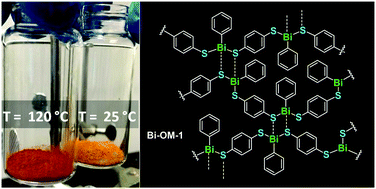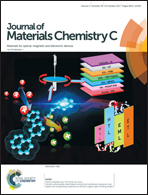Reversibly thermochromic bismuth-organic materials with tunable optical gaps†
Abstract
Five reversibly thermochromic bismuth-based inorganic–organic hybrid materials were synthesized via facile one-step condensation reactions between triphenylbismuth and four arenedithiols and a diselenol. The materials were characterized by UV-vis and FT-IR spectroscopy, powder X-ray diffraction (PXRD), energy dispersive X-ray spectroscopy (EDS), scanning electron microscopy (SEM), elemental analysis (EA), and thermogravimetric analysis (TGA). The bismuth-organic materials (Bi-OMs) are colored materials with optical HOMO–LUMO gaps that were readily tuned by systematic modification of the steric and electronic character of the π-conjugated organic linkers. All five Bi-OMs exhibit completely reversible thermochromism in the solid-state, and possess excellent thermal stability in air up to nearly 300 °C. This combination of physical properties, coupled with the ease of synthesis and the inexpensive, non-toxic nature of bismuth, make this class of inorganic–organic hybrid materials potentially promising for reversible smart window applications, camouflage coatings, temperature sensing, photocatalysis, color filters and displays.



 Please wait while we load your content...
Please wait while we load your content...